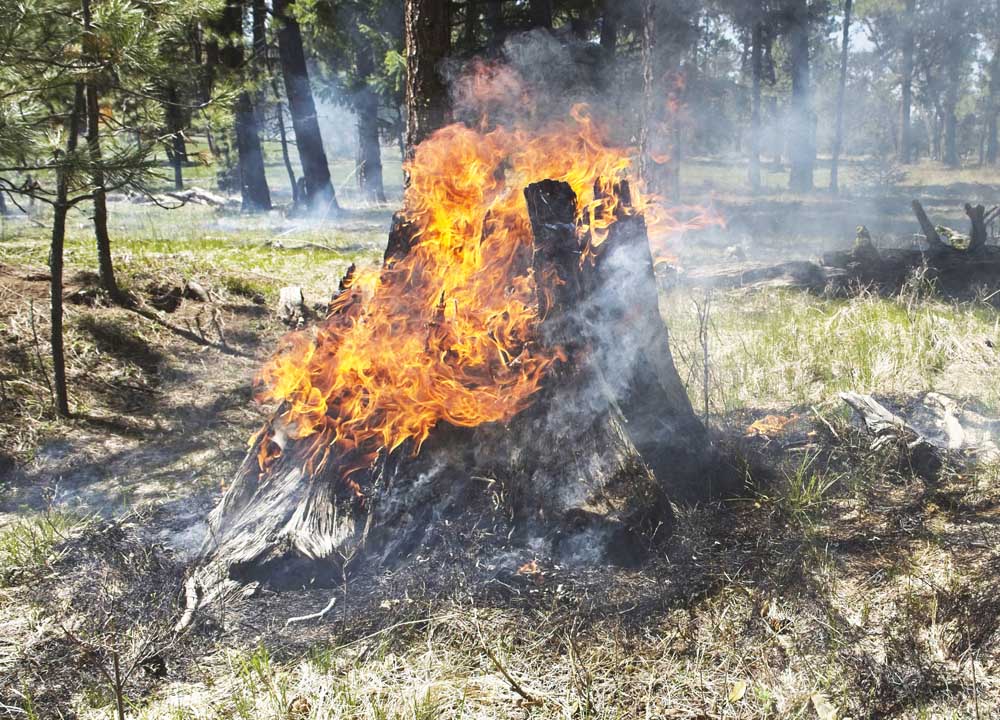Wildfire bills moving forward, but budgets could douse momentum
Published 7:30 am Tuesday, February 18, 2020

- A stump burns as part of last years USFS Chesnimnus prescribed burn. New and somewhat controversial bills in the Oregon legislature are intended to reduce wildland fire danger.
SALEM — Two bills Oregon lawmakers are considering this short session could be the one-two punch the state needs to considerably reduce the impact of wildfire on its landscape and citizens.
Wildfire is one of the preeminent threats to Oregon’s way of life in a multitude of ways, but the state is hoping this year it can make headway in minimizing its effects through an approach that takes both the short term and future into account.
The first is a bill — Senate Bill 1514 — creating 15 projects to be led by the state Forestry Department that would clear trees, underbrush and other forest material considered to be “fuel” for wildfire. The projects would take place in locations across the state determined by the department within the 5.2 million acres identified as high-risk areas by the Governor’s Council on Wildfire Response. The projects would be funded by a $25 million allocation laid out within the bill.
The second bill — Senate Bill 1536 — would overhaul the state’s approach to fire mitigation and suppression and help communities adapt to smoke and fire. It includes a lengthy list of new policies and regulations around:
•Assessing wildfire risk for utilities and having them create their own mitigation plans.
•Bolstering fire insurance and setting standards that encourage homeowners near forests to harden their homes against fire.
•Creating new positions within the state Office of Emergency Management to administer new mitigation and recovery efforts.
•Mitigating the health effects of smoke by helping homeowners in smoke-prone areas retrofit their homes with filtration systems.
•Establishing minimum standards of defensible space around homes.
•Setting a goal to annually treat 300,000 acres of forest and remove fuels to prevent fires from growing too large.
•Developing Oregon’s forestry workforce.
•Requiring the state fire marshal and state forester to help local jurisdictions, landowners, businesses and individuals create new wildfire service districts, or expand and adjust current ones, as well as providing financial help.
It’s unclear just how much Senate Bill 1536 would cost or where that money would come from. The Legislature’s budget committee’s fiscal impact statement found the proposal needs further work. The governor’s council estimated the cost at approximately $4 billion over the next 20 years, or about $200 million a year.
It’s a robust approach to many aspects of the conversation the Governor’s Council and legislators continue to have around reducing the impact of wildfire. But a party-line vote in the Senate Wildfire Committee last week to send both bills into the budget committee indicates Republicans might not have the appetite to tackle the entire plan now.
According to State Forester Peter Daugherty, waiting isn’t the best option.
“A lot of people would say, we’ve been waiting a number of years with fuel build ups and have known about the conditions for almost a decade and of the need for fuel reductions and restoration on federal lands,” Daugherty said.
Golden and Daugherty said they believe the “historic” deal between timber interests and environmental groups announced last week would have a positive bearing on discussions around wildfire investment.
With wildfire a major priority for Gov. Kate Brown, Democrats on the budget committee likely will keep step, but Republicans aren’t quite as convinced the bill should be addressed now.
“This is just too much too soon,” said Sen. Kim Thatcher, R-Keizer, a member of the Senate Wildfire Committee. “I might have been on board with a lot of this, but I just don’t want to commit to something I don’t fully grasp yet.”









